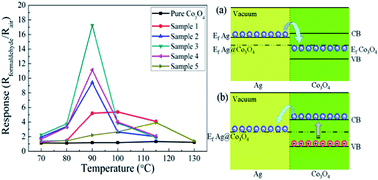Mechanism of enhancing the formaldehyde sensing properties of Co3O4via Ag modification
Abstract
Hollow Co3O4 hierarchical microspheres assembled from many compact nanowires have been successfully synthesized via a facile hydrothermal method from the precursor Co(CO3)0.5(OH)·0.11H2O followed by annealing treatment. The product has a well-defined morphology, is porous, and has a larger surface area as seen through various analytical characterizations; thus, it can act as a good basis for further modification to improve its gas-sensing properties. The sensing tests indicate that the Ag@Co3O4 composite formed via Ag modification can not only improve the sensing response to formaldehyde by several times that of pure Co3O4, but also reduce the optimum operating temperature of the sensor. Furthermore, the gas-sensing mechanism is also discussed in detail, including the effect of Ag addition on the electronic transfer of the Ag@Co3O4 composite. There are still many challenges in making a formaldehyde sensor with high sensitivity using the cheaper noble metal Ag as modified reagent via a facile synthesis and doping method.


 Please wait while we load your content...
Please wait while we load your content...